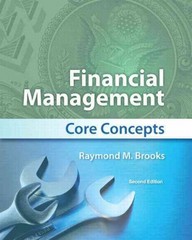Question
A pension fund manager is considering three mutual funds. The first is a stock fund, the second is a long-term government and corporate bond fund,
A pension fund manager is considering three mutual funds. The first is a stock fund, the second is a long-term government and corporate bond fund, and the third is a T-bill money market. The probability distribution of the funds is as follows:
|
| Expected Return | Standard Deviation |
| Stock Fund(S) | 16% | 12% |
| Bond Fund(B) | 8% | 4% |
| T-bill Fund(T) | 4% | 0% |
The correlation between the stock fund and bond bund is 0.3. The correlation between the T-bill money market fund and the other funds is 0.
(a) The manager chooses to invest 70% of a portfolio in stock fund (S) and 30% in bond fund (B). What is the expected value and standard deviation of the rate of return on his portfolio?
(b) Suppose that the manager decides to invest in a proportion of the total investment budget in stock fund (S) and all other in T-bill market fund (T), so that the overall portfolio will have an expected rate of return of 12%.
i. What is the proportion?
ii. What is the standard deviation of the rate of return on the managers portfolio?
(c) The manager has the utility function, U = E(r)-1/2Asigma^2. His degree of risk aversion is A = 2. If the manager is going to invest in the stock fund (S) and the T-bill money market fund (T) only. What proportion of the total investment should he invest in stock fund (S) and T-bill money market fund (T) to maximise his utility?
Step by Step Solution
There are 3 Steps involved in it
Step: 1

Get Instant Access to Expert-Tailored Solutions
See step-by-step solutions with expert insights and AI powered tools for academic success
Step: 2

Step: 3

Ace Your Homework with AI
Get the answers you need in no time with our AI-driven, step-by-step assistance
Get Started


